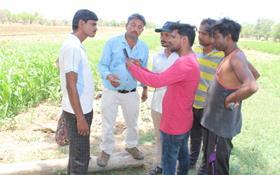
Western Sydney University (WSU) led a project has developed a smartphone app being used by Indian growers to manage groundwater reserves as the country struggles with drought and diminishing reserves.
The MyWell smartphone app allows users to monitor water levels in wells that supply drinking water and irrigation, report groundwater depth and rainfall, check dam water levels and water quality.
It is currently prominently used in Rajasthan and Gujarat by vegetable growers and a range of other farmers. The app is also being used in Laos and Pakistan and can be used in any location across the globe.
Experts estimate that by 2040, 21 Indian cities will run out of groundwater entirely and 40 per cent of the Indian population will have no access to drinking water.
In many places in India, water is hardly accessible for growing crops because the increasing use of industrial pumps to extract water from deep underground is slowly draining groundwater levels. As a result, water once available at 10m-15m depth is now only available at 30m or even deeper.
MyWELL is part of the project led by WSU and funded by the Australian Centre for International Agricultural Research (ACIAR) through the MARVI project.
'The MyWELL app supports the efforts of communities to be informed about the availability of local groundwater through the efforts of local, trusted volunteers called Bhujal Jankaars (BJs – a Hindi word that means ‘groundwater-informed’) These volunteers act as the intermediary between local people, organisations and governments in monitoring water levels through data collection in the MyWELL app,” said Basant Maheshwari, lead scientist in the MARVI project that developed the app.
'MARVI’s success is driven by its focus on village-level engagement, where local involvement close to water sources has created a distributed and reliable record of water availability, rainfall and water quality with easy-to-use measurement tools and the fact that everyone now has a smartphone.'
'This technology can be readily used in other countries, developing or developed, to manage water supplies more effectively,” Maheshwari added.






No comments yet